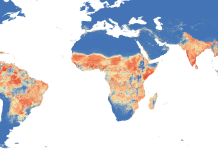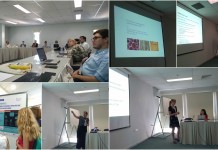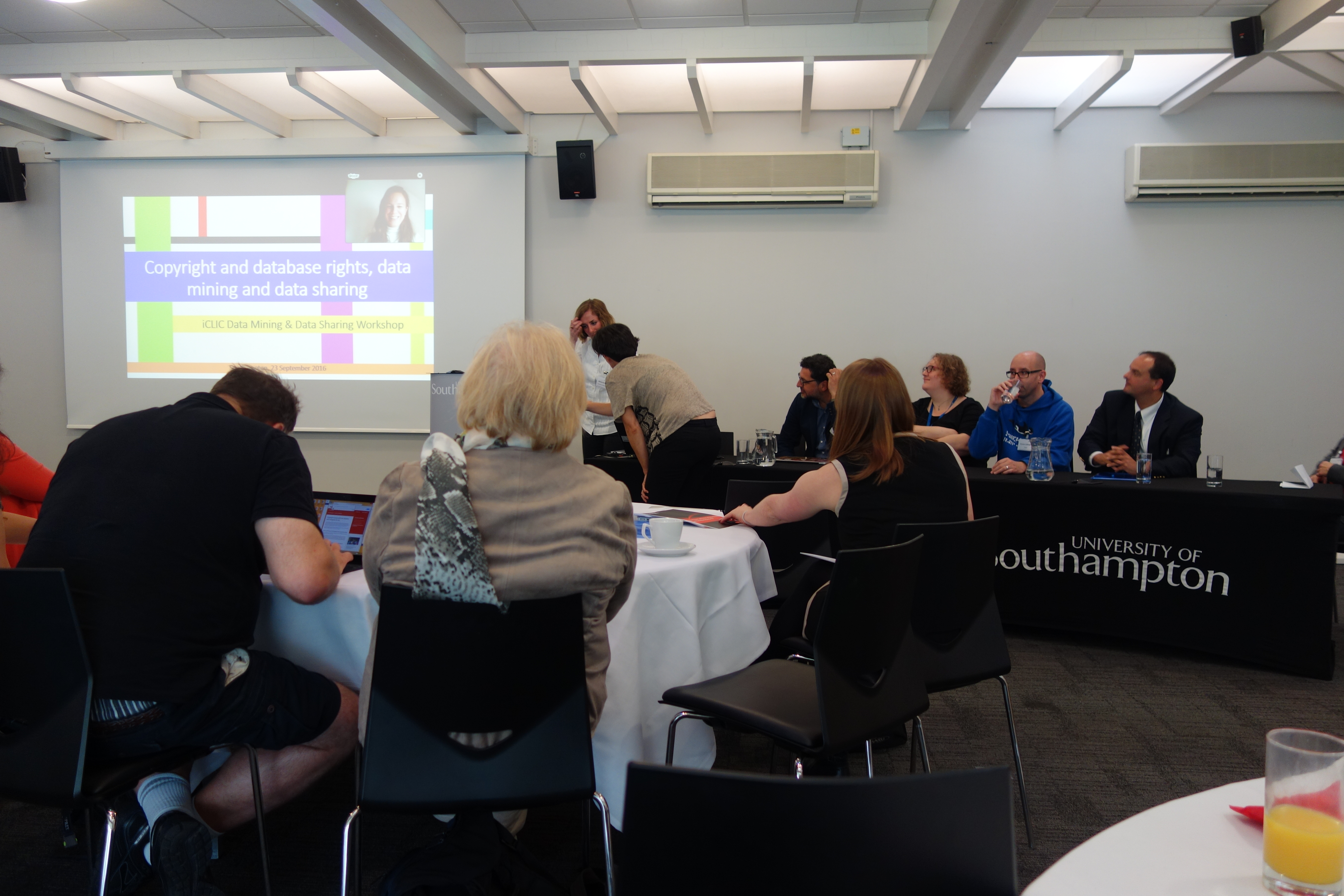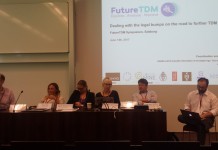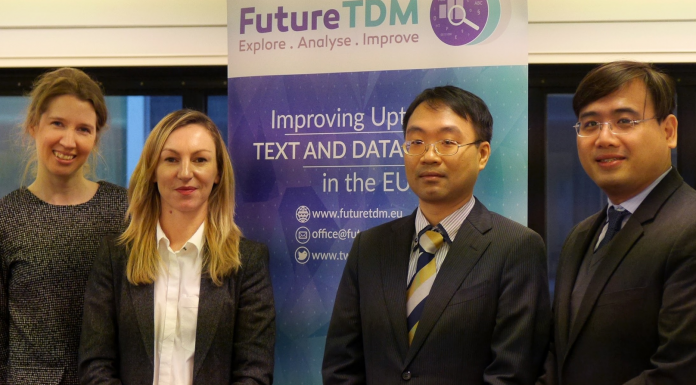Report 1: TDM exception, copyright reform process, temporary copying, reproduction right
The iCLIC Data Mining and Data Sharing workshop took place on 23rd September 2016 at the University of Southampton, addressing very timely topics around the changing regulatory frameworks of copyright, database and data protection laws.
The organisers, Sophie Stalla-Bourdillon, Eleonora Rosati and Micheál Ó Floinn, managed to bring together a good mix of legal scholars, policy makers and other stakeholders, including Margaret Haig from the UK's Intellectual Property Office (IPO), Carlo Scollo Lavizzari from the Legal Counsel of the International Association of STM Publishers (STM Association) and Trevor Callaghan from DeepMind (part of Google since 2014). There were about 40 attendees and as a contributor of the FutureTDM project, which is looking into topics overlapping with the workshop's topics, I took the opportunity to attend (The blog posts are personal opinions though, as can be seen in FutureTDM's Terms on blogging).
This is the first of three blog posts, all three specifically on the workshop's part on copyright and database law. This part mainly covers Julia Reda's keynote speech. The second part covers Estelle Derclaye's presentation and panel discussions, and the third part covers Margaret Haig's contribution and panel discussions.
One reason why the event was timely is that just over a week before the event the European Commission (EC) officially unveiled its new proposals to improve EU copyright (PDF), which heralds a new phase in a reform, which is in the process since at least 2013. Julia Reda (MEP) kicked off the workshop giving an introduction to how the new EC proposal deals with text and data mining (TDM). Below I summarized the ca. 1-hour speech and some Q&A with some notes in "[]" added.
The EC proposed a new copyright exception for TDM. It is limited in two ways: to scholarly purposes and by type of beneficiary. It is therefore broader than the TDM exception in place in the UK since it is not limited to non-commercial purposes, but it is also narrower, because it is limited to the type of beneficiary of "research organisations". [Marco Caspers has written a good analysis.]
The TDM exception is only for the reproduction right so that users may not be allowed to share results of TDM activities based on the exception. Beside highlighting those limits Julia posed the question why TDM is a copyright issue in the first place, when copyright is about protecting works [of expression] and TDM is just about extracting data and facts.
Going beyond the TDM exception she outlined other impacts the proposal would have on research. For example, the EC proposes a new 20-years lasting 'neighbouring right' [for press publishers], which applies retroactively and can therefore cause problems even for already existing scholarly works. [The STM Association, also aiming to tighten conditions concerning the 'lawful access'-condition of the proposed TDM exception, aims to get this neighbouring right extended to STM publishers]. This new right would apply even to non-copyrighted works, which is one way how TDM activities could be affected by it. Her résumé: we are still far away from an improvement for Open Science.
Julia went on illustrating the issues around TDM and copyright with analogies to other ['copying-reliant'] technologies. The issue in common is that such uses of works were never supposed to be covered by copyright in the first place. They become infringements in the digital environment while they were perfectly legal in the analogue environment - unless the copyright system is adapted. A hearing aid, for example, involves reproductions, but today it is not infringing, because EU copyright in 2001 had been adapted, introducing an exception for transient/temporary reproductions made purely for technological processes.
Despite the fact that this exception today is recognised as absolutely necessary, when it was introduced, it was subject of fierce lobbying and opposition. Publishers in particular argued that it would bring an end to their business models and that it was a gaping hole in the rightsholders' protection under the reproduction right, which, they explained, is a "core right in the analogue and digital world". But then no real problems actually arose. In a way TDM is similar to this. A mandatory TDM exception, which is equivalent to 'the right to read is the right to mine' would actually not cause any harm to anyone. As the hearing aid helps to listen to music, TDM helps to read large amounts of texts.
Such claims are made in the policy context, creating fear. One such claim in today's context of TDM is that TDM is a highly complex activity, which can only be done with expert tools, which publishers are providing and therefore you have to cooperate with those publishers anyway and the best way to do this is through a license. Julia's answer to this: TDM saves users a lot of money and working hours, and if TDM is really so complex, then simply providing the tools should be a viable business model and you don't need an exclusive right for that.
Another claim is that TDM puts a strain on publishers' servers. Publishers from Reed Elsevier [RELX Group] elaborated on this, explaining that doctors in the emergency room need to be able to access these databases within three seconds when they are treating Ebola patients. Julia's reply is that this is not necessarily the case. But this claim has actually made it in the EC proposal. While contract override is not allowed under the new EC proposal, related to the 'server strain'-claim, it has Article 3.3 on technical protection measures (TPMs), which allows rightsholders to limit access to content to "ensure the security and integrity of the networks and databases where the works or other subject-matter are hosted".
This clause opens the door to a lot of arbitrary limitations for TDM, because it would be very difficult to disprove, if a publisher makes a claim on the basis of this clause. But the EC says it won't be a problem, because the rules of the 2001 InfoSoc Directive continue to apply and they were sufficient to prevent the abuse of TPMs.
The problem with this is that member states have rarely enforced this part of the InfoSoc Directive. In practice, if you are kept from using an exception with a TPM it is very difficult to go and ask your member state to do something about it. It would be probably better to remove this Article 3.3 altogether. Security of publishers' servers is not necessarily a real concern [which has been confirmed also by large scholarly publishers].
Another claim is that you can just get a licence for TDM. This is based on the assumption - which is not always correct - that TDM users use materials from a small number of relatively large academic publishers. But any material can be mined, blogs, e.g. It would be disproportionate to find and ask all rightsholders for your TDM-based study. So, to get licenses is not necessarily a practical advice. At the end of the day people might just ignore the problem altogether, because TDM is performed all the time and it constitutes a large part of the Internet traffic. A lot of this may be covered by the InfoSoc Directive's temporary copy exception, but some countries outside the EU have already taken steps to make it clearly legal. Japan's TDM exception adopted in 2012 basically covers any TDM activity regardless of whether it is commercial or non-commercial use. Transaction costs associated with licensing was one of the reasons for introducing this exception, applicable also to Japan's technology companies.
Furthermore, TDM has been addressed by courts and on fundamental rights grounds. The District court of Amsterdam ruled that prohibiting TDM on the rightsholder's side on grounds of copyright is disproportionate and an infringement on the fundamental freedom of research. This ruling is significant, because it shows that there is a chance that TDM will solve itself through case law, without any need for legislative intervention. This is why the adoption of a narrow exception is quite dangerous - because, if you put in law explicitly that some TDM is permitted, the conclusion of the court probably is that everything outside of this exception is clearly not covered.
It seems absurd to keep an activity so essential in our digital world such as TDM in the legal grey zone just to please a few academic publishers that are already among the most profitable companies in the world.
Closing her speech Julia explained that to reconcile copyright with digital technologies a more radical reform than just a TDM exception is needed: changing the scope of the reproduction right. Reproductions/copies are made all the time these days using digital technologies and for many of the issues, which arise with this ubiquitous copying, copyright is just not the right tool to address them. Every few years we have to adjust copyright to new technologies and every time it is a struggle. Eventually, all instances of digital copying that don't involve an element of making available or distribution are covered by an exception simply because digital technology. But do we then still need a digital reproduction right? Does it actually make sense in the digital world to build our whole foundation of copyright on the basis of the act of copying? And do the benefits of this right justify the mass of collateral damage to [/ associated with the inhibiting of] the development of digital technology?
In the physical world it makes sense that the act of copying is identified as infringement. This had been introduced to solve a difficult copyright enforcement problem. If someone has 20,000 printed copies of a book in his basement, you don't want to wait until those copies get sold, because you know that the purpose of the copies is to sell them or give them away. Therefore, you make the copying itself an infringement, because it is much easier to go after that.
In the digital world it is different. Each copy is made at the same time as the making available takes place. So, you actually don't need the reproduction right in this case. The additional benefits the reproduction right gives you in the analogue world don't apply in this situation. So, in the digital world the reproduction right has questionable benefits, but at the same time causes collateral damage. You can solve this with patches, with exceptions, but better would be to limit the exclusive right in a way so that it makes sense, perhaps, for example, by making the reproduction right implicit to the making available right for digital works.
Julia finished her speech with a call for everyone to get involved in the copyright reform process. Pushing for a TDM exception is not a radical demand - it is just bringing copyright back in balance.
A short Q&A followed. One question was about how TDM exceptions (can) apply for uses in the public sector, which is not clearly research. Julia's answer: Best is to show that you have a public interest mission, because, if you do, you don't have to be not-for-profit as well. Both conditions apply to research organisations. The approach of defining organisations as beneficiaries is not favourable in the first place, but one way to include public service organisations to be covered by a TDM exception would be to say that you have a public interest mission regardless of the uses being research uses or not. For example, it is unclear why the EC didn't include schools in their proposed TDM exception.
The second question concerned the EC's 'fair compromise'-approach in getting to the proposal. The risk of under-representation of the public interest with this approach (or in how it pans out in practice) was pointed out.
The EC proposal is now to be discussed by the European Parliament and the Council of the EU, and another question during the Q&A was about the Council's stand with regard to an EU-wide TDM exception, as expressed in the recent Council Conclusions. While the Conclusions endorse a broader exception by not limiting it to a particular type of beneficiary, it was pointed out that in the document it sounds like limited by type of content, which would be more like the French approach. However, this language might be just because those Conclusions are particularly about research and Open Science.
The last question was about data-mining streams such as Twitter. In this context Julia reminded that IT infrastructure design for TDM-activities can be less optimised towards speed and reproducibility, if it needs to be more optimised towards legal requirements.
--
If you are interested in those topics, check out the FutureTDM website and the FutureTDM workshop taking place on 27th September 2016 (possibly with video life stream).
// All blog posts are the personal opinion of the bloggers. For more information see FutureTDM's DISCLAIMER on how we handle the blog. //




